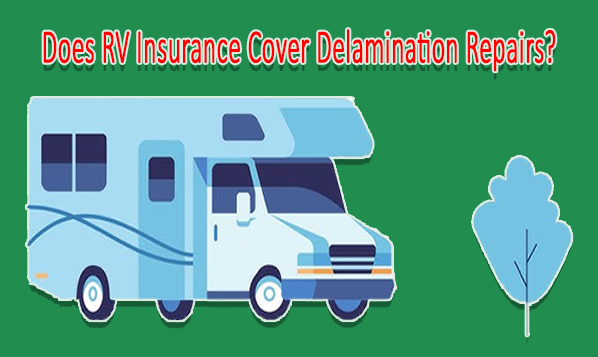Recreational vehicles (RVs) can present special maintenance problems, like delamination, as they provide freedom and adventure. Delamination is the process by which an RV’s outer fiberglass coating splits from its underlying structure. This is a result of manufacturing flaws or water penetration. However, many RV owners ask if their insurance would cover the price of delamination repairs since it can be costly.

To safeguard your investment, you must be aware of what RV insurance normally covers, when delamination may be covered, and how exclusions work. To assist owners in navigating the complexities of RV insurance, this article helps determine whether RV insurance can cover delamination repairs and offers insights into the factors that may affect coverage.
What is Delamination
Delamination in an RV begins with small fractures in its lamination, the outer layer that protects it from corrosion and damage. The exterior layer of fiberglass or gel coat separates from the core layer of plywood and Styrofoam underneath as a result of these fissures spreading outward. Additionally, owners of older RVs with broken or poor seals frequently experience this problem, which is not covered by RV insurance.
Does RV Insurance Cover Delamination Repairs
Due to carelessness and neglect, RV insurance usually does not cover delamination repairs. Delamination, which happens when an RV’s outer layers split, may be extremely harmful if left untreated. Additionally, insurance companies regard delamination as a preventable defect, so the expense of repairs is not covered.
Delamination may be avoided with routine maintenance, and owners are encouraged to check their cars frequently and patch any cracks they find. In the long term, proper immanence can shield financial interests and stop delamination.
When Does RV Insurance Cover Delamination Repairs
Generally, RV delamination claims are covered if the damage happens suddenly and without warning. One-vehicle crashes and natural disasters are frequent examples. For example, if a tree falls on the roof of your RV during a hurricane, the structure may sustain damage and water leaks.
Delamination may also occur from a flash flood brought on by a tree or fence. Your insurance provider views these events as unexpected and unintentional; therefore, your comprehensive policy probably covers them. The entire cost of fixing the delamination on your equipment will be covered by your provider.
When Does RV Insurance Not Cover Delamination Repairs
If the damage was determined to be the result of neglect, regular wear and tear, or inadequate maintenance of your rig, RV delamination is not covered. In those cases, your insurance company will probably conclude that the delamination could have been avoided, and you will be responsible for fixing the damage yourself.
What Causes RV Delamination
There are various causes of delamination, and here are some common causes for why delamination occurs:
- Water: The connections holding the layers together are broken if moisture enters the area between the outer layer and the substrate.
- Defects from the manufacturer: The surface of the RV may develop bubbles or bulges as a result of using inferior or improperly applied bonding chemicals.
- Typical deterioration: The body may develop tiny stress cracks as a result of the RV structure flexing. These cracks usually don’t cause any issues if they are fixed promptly. However, the structural integrity of the RV may be jeopardized if any moisture manages to seep into the fractures.
- Negligence: Consistently monitor the RV’s structural integrity, just like you would while checking your car’s tire pressure or oil levels.
How Much Do RV Delamination Repairs Cost
Repairing RV delamination can be costly. In certain cases, the cost of repairing RV delamination may involve replacing the entire wall, roof, or floor. This is going to cost you at least a couple of thousand bucks. The cost of the kits to fix your RV can range from $100 to $500, and there’s no assurance that they will work. This is particularly true if you have never used the procedure before. Another choice is to hire a professional, which starts at about $1,000.
How to Prevent RV Delamination
Inspect all sealants every six months to protect the exterior of your RV, particularly if you live in a moist climate like the Pacific Northwest. Examine the roof, the four sides, the doors, the moldings, the vents, and the attachments. Furthermore, home sealants are incompatible with fiberglass exteriors, so choose a dependable sealant made especially for your RV.
Additionally, you should check your motorhome or travel trailer for some typical delamination symptoms every few months:
- Tears
- Cracks
- Sponginess
- Water-related harm
- Bubbles
- The ripples
- Creases
- Hollow sounds
It is expected that an RV would require maintenance, and RV insurance does not cover repairs resulting from delamination. You can ask your insurance provider for clarifications to make sure you are sufficiently covered against different kinds of hazards and dangers. Remember that by properly maintaining your car, you can avoid delamination.

